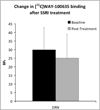Antidepressant treatment reduces serotonin-1A autoreceptor binding in major depressive disorder
- PMID: 23374637
- PMCID: PMC3690146
- DOI: 10.1016/j.biopsych.2012.11.012
Antidepressant treatment reduces serotonin-1A autoreceptor binding in major depressive disorder
Abstract
Background: Chronic selective serotonin reuptake inhibitor (SSRI) administration to rodents desensitizes or downregulates raphe 5-hydroxytryptamine 1A (5-HT1A) autoreceptors. We previously found elevated 5-HT1A binding in antidepressant-naive and not recently medicated major depressive disorder (MDD) and now report the effect of SSRI treatment on 5-HT1A autoreceptors in depressed patients.
Methods: 5-HT1A binding (BPF) was quantified in medication-free subjects using positron emission tomography (PET) with [11C]-WAY-100635 before and after treatment of MDD with an SSRI for 5 to 9 weeks (mean 47 ± 8 days). Nineteen subjects without recent history of antidepressant pharmacotherapy completed both [11C]WAY-100635 PET scans with a metabolite-corrected arterial input function and depression severity was rated before and after the treatment course.
Results: 5-HT1A autoreceptor BPF in the raphe was reduced 18% on SSRI treatment (df = 1,18; F = 5.12; p = .036). However, the degree of reduction in 5-HT1A autoreceptor BPF was unrelated to improvement in depression (df = 1,16; F = 1.27; p = .276).
Conclusions: Downregulation of 5-HT1A autoreceptor binding by SSRI treatment of major depression is consistent with animal studies. This may be a necessary but insufficient requirement for clinical response to SSRIs. A PET agonist ligand that binds selectively to the high-affinity conformation of this receptor can determine whether SSRIs also cause desensitization of the autoreceptor as reported by some rodent studies and whether that effect may be related to clinical response.
Copyright © 2013 Society of Biological Psychiatry. Published by Elsevier Inc. All rights reserved.
Conflict of interest statement
The other authors report no biomedical financial interests or potential conflicts of interest.
Figures


Similar articles
-
Antidepressant medication exposure and 5-HT1A autoreceptor binding in major depressive disorder.Synapse. 2019 Jun;73(6):e22089. doi: 10.1002/syn.22089. Epub 2019 Feb 19. Synapse. 2019. PMID: 30693567
-
Brain serotonin 1A receptor binding as a predictor of treatment outcome in major depressive disorder.Biol Psychiatry. 2013 Nov 15;74(10):760-7. doi: 10.1016/j.biopsych.2013.03.021. Epub 2013 May 9. Biol Psychiatry. 2013. PMID: 23664414 Free PMC article. Clinical Trial.
-
Higher 5-HT1A autoreceptor binding as an endophenotype for major depressive disorder identified in high risk offspring - A pilot study.Psychiatry Res Neuroimaging. 2018 Jun 30;276:15-23. doi: 10.1016/j.pscychresns.2018.04.002. Epub 2018 Apr 13. Psychiatry Res Neuroimaging. 2018. PMID: 29702461 Free PMC article.
-
Serotonin-1A receptor imaging in recurrent depression: replication and literature review.Nucl Med Biol. 2007 Oct;34(7):865-77. doi: 10.1016/j.nucmedbio.2007.06.008. Nucl Med Biol. 2007. PMID: 17921037 Free PMC article. Review.
-
Looking back (and in)to the future: A personal reflection on 'Serotonin autoreceptor function and antidepressant drug action' (Hjorth et al., 2000).J Psychopharmacol. 2016 Nov;30(11):1129-1136. doi: 10.1177/0269881116647621. Epub 2016 May 10. J Psychopharmacol. 2016. PMID: 27166363 Review.
Cited by
-
Higher pretreatment 5-HT1A receptor binding potential in bipolar disorder depression is associated with treatment remission: a naturalistic treatment pilot PET study.Synapse. 2013 Nov;67(11):773-8. doi: 10.1002/syn.21684. Epub 2013 Jun 17. Synapse. 2013. PMID: 23720414 Free PMC article.
-
Imaging the serotonin 1A receptor using [11C]WAY100635 in healthy controls and major depression.Philos Trans R Soc Lond B Biol Sci. 2013 Feb 25;368(1615):20120004. doi: 10.1098/rstb.2012.0004. Print 2013. Philos Trans R Soc Lond B Biol Sci. 2013. PMID: 23440462 Free PMC article. Review.
-
Lack of association between the serotonin transporter and serotonin 1A receptor: an in vivo PET imaging study in healthy adults.Psychiatry Res Neuroimaging. 2016 Sep 30;255:81-6. doi: 10.1016/j.pscychresns.2016.08.002. Epub 2016 Aug 8. Psychiatry Res Neuroimaging. 2016. PMID: 27567324 Free PMC article.
-
Regulation of monoamine transporters and receptors by lipid microdomains: implications for depression.Neuropsychopharmacology. 2018 Oct;43(11):2165-2179. doi: 10.1038/s41386-018-0133-6. Epub 2018 Jun 28. Neuropsychopharmacology. 2018. PMID: 30022062 Free PMC article. Review.
-
Estimating Risk of Antidepressant Withdrawal from a Review of Published Data.CNS Drugs. 2023 Feb;37(2):143-157. doi: 10.1007/s40263-022-00960-y. Epub 2022 Dec 14. CNS Drugs. 2023. PMID: 36513909 Free PMC article. Review.
References
-
- Maes M, Leonard BE, Myint AM, Kubera M, Verkerk R. The new '5-HT' hypothesis of depression: Cell-mediated immune activation induces indoleamine 2,3-dioxygenase, which leads to lower plasma tryptophan and an increased synthesis of detrimental tryptophan catabolites (TRYCATs), both of which contribute to the onset of depression. Prog Neuropsychopharmacol Biol Psychiatry. 2010 - PubMed
-
- Zarcone VP, Jr, Berger PA, Brodie KH, Sack R, Barchas JD. The indoleamine hypothesis of depression: an overview and pilot study. Dis Nerv Syst. 1977;38:646–653. - PubMed
-
- Neumeister A. Tryptophan depletion, serotonin, and depression: where do we stand? Psychopharmacology bulletin. 2003;37:99–115. - PubMed
-
- Lanfumey L, Hamon M. 5-HT1 receptors. Curr Drug Targets CNS Neurol Disord. 2004;3:1–10. - PubMed
-
- Blier P, de Montigny C, Chaput Y. Modifications of the serotonin system by antidepressant treatments: implications for the therapeutic response in major depression. J Clin Psychopharmacol. 1987;7:24S–35S. - PubMed
Publication types
MeSH terms
Substances
Grants and funding
LinkOut - more resources
Full Text Sources
Other Literature Sources
Medical
Miscellaneous

